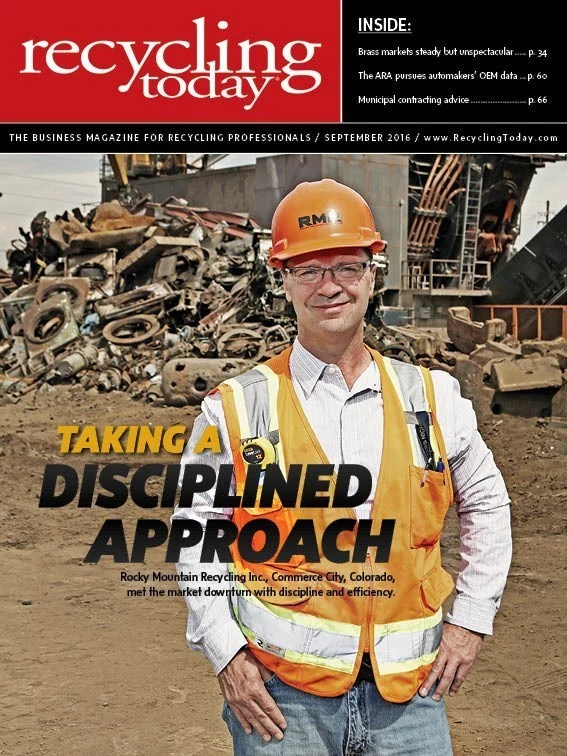APR responds to plastic can recyclability claims
The Association of Plastic Recyclers (APR), Washington, an international trade organization representing the plastics recycling industry, has responded to claims by plastic can manufacturers that their products are recyclable, saying PET (polyethylene terephthalate) cans with metal lids contaminate the PET recycling stream. APR says it urges companies considering the use of plastic cans to proceed with caution.
“There is a reason Maine, Illinois and Minnesota imposed restrictions or bans on this type of packaging,” says Steve Alexander, executive director of APR. “A plastic can with a metal lid is a contaminant to PET recycling and not compatible with today’s material recovery and plastics reclamation systems.”
The state restrictions were imposed in response to production of plastic cans in the 1980s and their negative impact on the recycling process. These laws remain in effect today and have led many companies to withdraw support of this type of container.
Although the PET portion of the can may be recyclable, the metal lid is seamed onto the PET, APR says, and no practical solutions are available to separate the two materials in material recovery facilities (MRFs), rendering the entire container nonrecyclable.
“APR has already reached out to companies producing plastic cans to voice the concerns of the plastic recycling industry,” says Byron Geiger, president of Custom Polymers PET, Athens, Alabama, and chairman of the APR PET Technical Committee. “Brand companies consistently require suppliers to provide evidence of compatibility with recycling. The APR works with companies to ensure this is possible and offered this support in communication with plastic can manufacturers.”
The APR says it has created laboratory test methods used to assess the impact of new innovations to the recycling market as part of The APR Champions for Change program. Companies use these tests to confirm their innovations do not interfere with recycling. Once testing requirements are met, those companies receive APR Critical Guidance Recognition. This process addresses the challenge of introducing packaging that is consistent with recycling technology, and the APR says it encourages plastic can producers’ participation.
Additional information about metal components or attachments on PET containers is detailed in The APR Design Guide for Plastics Recyclability, available at http://bit.ly/2bxShDU.
PET bottle recycling widely available
Most Americans have access to recycling programs that accept beverage containers, according to a study commissioned by the Sustainable Packaging Coalition (SPC), Charlottesville, Virginia, with participation from SPI: The Plastics Trade Association, Washington.

The study, “2015-16 Centralized Study on Availability of Recycling for Beverage Containers,” identifies the prevalence of recycling programs that accept beverage containers, including polyethylene terephthalate (PET) bottles, jugs and jars, used aluminum beverage cans (UBCs), glass beverage bottles and aseptic cartons. The findings show that 92 percent of the U.S. population can recycle PET bottles, jugs and jars.
“It’s important to make recycling available to consumers. The more convenient we can make recycling for consumers, the more people will recycle,” says George Southworth, director of industry affairs, Rigid Plastic Packaging Group (RPPG) and Pharmaceutical and Medical Device Applications Committee (PMDAC) at SPI. “This study shows many Americans have the resources they need to recycle, so it’s up to us to keep educating and advocating for more effective recycling.”
The study also finds that 54 percent of U.S. residents have automatic/universal curbside recycling of PET bottles, jugs and jars. The other curbside programs were opt-in, which is available to 6 percent of the population, and subscription, which is available to 8 percent of the population. In total, 68 percent of U.S. residents have curbside recycling available.
Drop-off programs are available to 24 percent of the U.S. population and, when combined with the curbside recycling, totals 92 percent of all programs—curbside and its subsidiaries and drop-off programs—available to the U.S. population, according to the study.
Resource Recycling Systems, Ann Arbor, Michigan, and Moore Recycling Associates, Sonoma, California, conducted the study. Project sponsors also included the Can Manufacturers Institute, Carton Council, Glass Packaging Institute, National Association for PET Container Resources (NAPCOR) and The Aluminum Association.

Explore the September 2016 Issue
Check out more from this issue and find your next story to read.
Latest from Recycling Today
- BMW Group, Encory launch 'direct recycling’ of batteries
- Loom Carbon, RTI International partner to scale textile recycling technology
- Goodwill Industries of West Michigan, American Glass Mosaics partner to divert glass from landfill
- CARI forms federal advocacy partnership
- Monthly packaging papers shipments down in November
- STEEL Act aims to enhance trade enforcement to prevent dumping of steel in the US
- San Francisco schools introduce compostable lunch trays
- Aduro graduates from Shell GameChanger program





